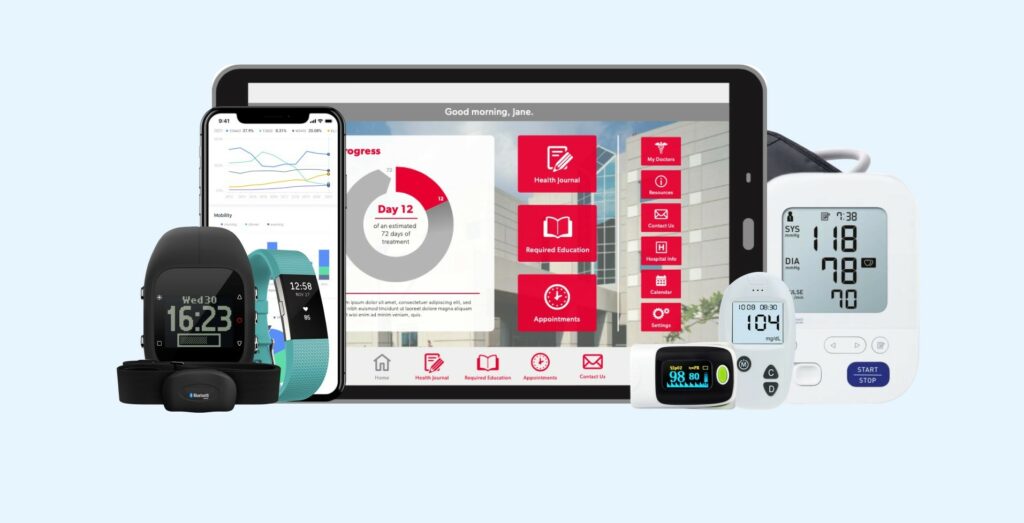Today IoT is one of the most widely discussed technologies. It is applied in various spheres from manufacturing to the fitness industry. However, in this article, we’d like to focus on one very important but, probably, less well-known sphere where the Internet of Things solutions have great value. It is the social sector and, namely, IoT solutions for senior citizens. Let’s have a look at how IoT helps to ensure independent and secure living for elderly people and to reduce stress for their families who are not able to stay with their senior relatives 24/7.
Security and safety
These days there are a lot of IoT devices for elderly care that are intended for enhancing safety in living spaces. These devices are enriched with special sensors for monitoring air quality, humidity, and temperature and can send notifications to family members if any dangerous changes are detected.
There are also different smart devices that can ensure the security of seniors’ apartments and houses. They can be used for controlling window and door opening and detecting unauthorized entries for further notifying security agencies or authorities.
If you are working with a software company that provides IoT development services for building a custom solution of this kind, you can enrich it with any functionality that you find valuable for end-users. That’s why a range of the available features can be significantly wider than we have enumerated.
Everyday tasks
Smart devices can also facilitate a huge variety of different everyday tasks for the elderly by fully revolutionizing the way how this or that task should be performed. The brightest example of this use case is a smart speaker. Thanks to such a device, a person even doesn’t need to take a smartphone or turn on a laptop to call somebody, get a consultation with a doctor, or even order groceries.
Also, smart bracelets can notify seniors about important events that shouldn’t be forgotten. It helps elderly people to be sure that they won’t miss the anniversaries or birthdays of their family members as they will get a notification in advance.
Health state monitoring
As health is one of the most crucial aspects when we are talking about elderly care, there are a lot of smart devices, including wearables. They help to monitor vital parameters (such as glucose level or blood pressure) which is extremely important when a person suffers from chronic diseases.
The results gathered by these smart devices further go to the cloud platform where a healthcare organization or a medical center can get access to them. Thanks to these real-time data, doctors can timely detect problems and react to them in an appropriate way. Also, IoT solutions can automatically send notifications to medical staff when a monitored parameter reached a critical level.
It is also worth mentioning that modern technologies help to prevent or at least mitigate the consequences of falls that can be a result of numerous issues, such as eyesight problems, neurological disorders, etc. If a person can’t call for help after a fall, IoT devices will send a notification to a medical organization after analyzing the location of a wearer and monitoring his/her movements within a particular period of time.
Some of the modern solutions that are available today are intended for preventing falls. According to the data published by the US Centers for Disease Control and Prevention, every year there are reports of over 36 million falls among elderly citizens, and 32,000 cases lead to death. Wearable devices powered with sensors monitor movement patterns in combination with location and if a risk of a fall is detected, a user will be notified. Very often such solutions have motion sensors. If these sensors do not detect any movement within a set time, medical staff or relatives will get an alert. As a result, there are high chances that medical aid will be provided in time.
There are solutions for people who suffer from different chronic diseases. For example, apps for users with diabetes work based on the data provided by connected blood sugar monitors and send notifications to doctors when the blood sugar level is low. There are also IoT products for people with arthritis, Parkinson’s disease, and heart diseases.
Moreover, there is a wide choice of smart products for elderly people with special needs. For example, some solutions can translate written text into Braille or decrease the level of background noises and send the necessary sound directly into the ear canal of a user.
Closing word
As you can see, the range of IoT solutions for seniors is already rather wide today. And at the same time, it is constantly growing thanks to the innovative ideas brought to the market. All this has become possible with the introduction of cutting-edge software apps in combination with new smart devices aimed at dealing with different tasks. Given all the benefits that these solutions offer to society, IoT apps that are focused on the needs of elderly people can be a very promising segment to enter.
